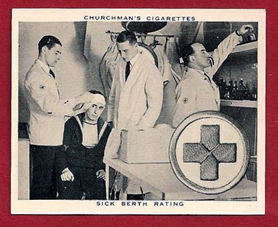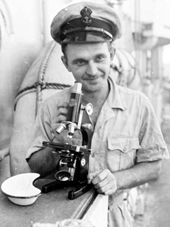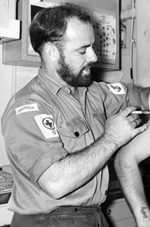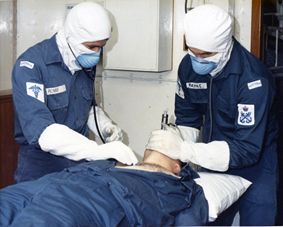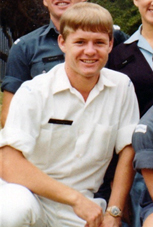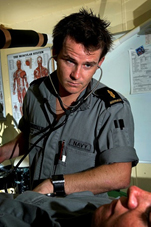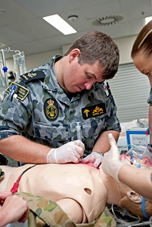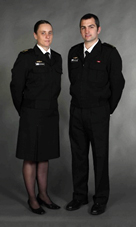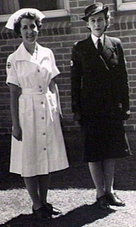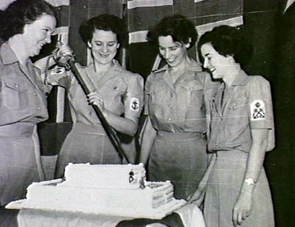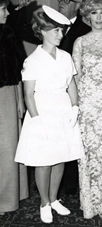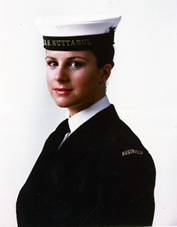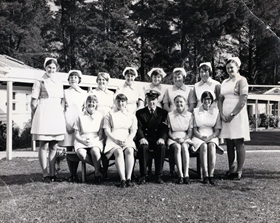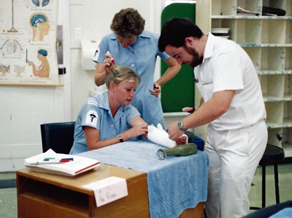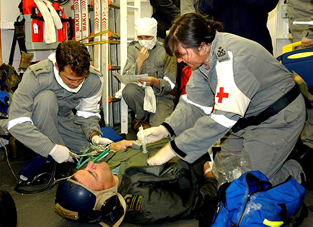By Commander Neil Westphalen, Royal Australian Navy
This paper was first published in the Journal of Military and Veterans’ Health, Volume 26 Number 3 in July 2018. Commander Westphalen is a member of the Society and Active Reserve. He served as the Fleet Medical Officer from 2013 to 2016. Additional biographical details are at the end of this paper.
Purpose
More than a century after its establishment, many Royal Australian Navy (RAN) uniforms and ranks continue to reflect those used by the (British) Royal Navy (RN). The first of this three-part article described the history of Navy sailor uniforms since 1509,[1] while this part examines the development of Navy medical and dental sailor uniforms for male and female personnel since 1879. The third will describe the evolution of Navy medical and dental sailor rank and rate badges since 1827.
A subsequent article will do likewise for RAN health officers.
Male Medical and Dental Sailors
The first documented reference to Navy medical assistants is dated 1597. They were called ‘loblolly boys’, the name derived from a thick porridge, sometimes enhanced with pieces of meat or vegetables, for sick and injured crewmembers. ‘Loblolly boys’ also restrained patients during surgery, obtained and cleaned surgical instruments, disposed of amputated limbs, and emptied and cleaned toilet utensils.[2]
These duties were performed at sea on an ad hoc basis, by sailors or marines who either had some interest in caring for the sick, or were deemed useless for other seagoing duties. They were also sometimes performed by women, who varied from sailor’s wives to prostitutes.[3] It was not until the early 18th century that they conducted their duties in a dedicated sick bay.[4]
Meanwhile, treatment for ill and injured British seamen ashore before 1672 was provided wherever accommodation was available, in accordance with the Laws of Oléron.[5] The first British naval hospital was founded that year at Plymouth, during the Third Dutch War (1672-74). Additional Navy hospitals followed in 1691 at Greenwich and Chatham during the War of the Grand Alliance (1688-97), and at Portsmouth in 1745 during the War of Jenkin’s Ear (1739-48).[6]
Over the next century, nursing duties ashore were conducted on similar but separate terms to that afloat, by non-qualified non-proficient female nurses, assisted by itinerant pensioners and labourers. The women were replaced by men in 1854, with a view to amalgamating nursing care ashore with that afloat. However, these men were still not assessed for their suitability for nursing duties, let alone received any training.[7]
Meanwhile in 1830, sailors who had completed gunnery training in Portsmouth aboard HMS Excellent (later moved ashore to Whale Island), were the first to be given a formal job description or ‘rate’ as gunners.[8] Although ships’ captains were first instructed to allocate dedicated staff for sick bay duties in 1833, these personnel were only required to pass a medical examination, be over 18 years old, be able to read and write, and possess a fair knowledge of keeping accounts.[9]
While these seagoing health staff were divided into three classes (Assistant Sick Berth Attendant, Sick Berth Attendant, and Sick Berth Steward), their progression through these ranks was entirely dependent on local Service requirements, resulting in wide and unfair variations. When not at sea, they undertook non-medical duties, whether they were released to work in local port hospitals, or retained aboard non-seagoing ‘guard ships’.[10]
It was not until 1884 that sick berth staff received formal training and a career structure, the latter based on that already used for officer stewards.[11] On completing 18 months training, sailors were rated Sick Berth Attendants and sent to sea. After three years they were eligible for promotion to Second Class Sick Berth Steward (equivalent to Second Class Petty Officer), and sent back to sea. After another three years, they were rated First Class Sick Berth Steward (equivalent to First Class Petty Officer).[12]
Selected sick berth stewards were then promoted to Wardmaster (equivalent to Chief Petty Officer) after 14 years’ service, for hospital duties ashore. In 1900, the rank of ‘Head Wardmaster’ was established (equivalent to Warrant Officer),[13] thereby instigating what eventually became the current Medical Administration Officer branch.[14]
While Sick Berth Attendants initially wore the same ‘square rig’ as seaman branch personnel, First Class Sick Berth Stewards and above wore ‘fore-and-aft rig’ with double-breasted jackets, ties and peaked caps, while Wardmasters wore a single-breasted long frock coat. White tunics were worn in the hospital wards.[15]
In 1890, all CPO ‘fore-and-aft’ jackets acquired gilt buttons and became the ‘Class I’ rig, while the ‘square rig’ became ‘Class II’ uniform worn by ‘military branch’ seaman personnel. ‘Class III’ uniform referred to ‘fore-and-aft’ double-breasted jackets ties and peaked caps, with black horn rather than gilt buttons, for wear by non-seamen ‘civil branch’ personnel. Among other branches, these included s junior sailor sick berth stewards and ‘artificer’ engineering sailors,[16] which probably explains why Navy medical staff can still be referred to today as ‘sickbay tiffies’. Class III rig for male medical and dental junior sailors was not abolished in the RAN until 1959.[17]
In 1921, all sick berth stewards were renamed Sick Berth Attendants (SBAs).[18] The RAN introduced dental mechanics in 1920,[19] who were issued with ‘bluette’ (medium blue) working overalls from 1925.[20] RAN dental rates were split from SBAs into their own dedicated branch in 1948.
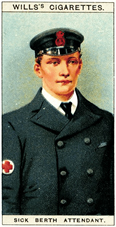
In 1953, the RAN replaced the white jackets for medical and dental sailors undertaking patient duties with the current white ward working dress.[21] RAN SBAs and dental assistants were renamed Medical and Dental sailors in 1974.[22
All ‘square rig’ and ‘fore-and-aft rig’ uniforms for office-type duties, were replaced by the current utility or ‘battledress’ rig (similar to that worn by Army and Air Force personnel) in 1998.[23]
Right: Sick Berth Attendant in Class III ‘fore-and-aft rig’, 1909.[24] Note the double-breasted jacket with black horn buttons, peaked cap with red cap badge, and Geneva cross on the right upper arm.
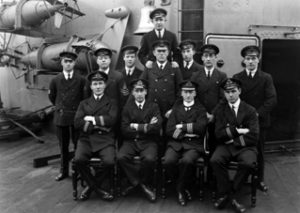
Female Medical and Dental Sailors
44 female health sailors (including 11 dental sailors, and a single dental mechanic)[32],[33] served from 1941 to 1948 in the wartime Women’s Royal Australian Naval Service (WRANS).[34] The winter uniform for WRANS junior sailors consisted of a suitably adapted Class III jacket, matching skirt and broad-brimmed felt hat, with the same cap badge worn by males. A blue summer frock with a white belt and collar was introduced in early 1942, which was replaced from 1943 until 1953 with a khaki dress.Female Medical and Dental Sailors
Female SBAs were recruited into the postwar WRANS from its recommencement in 1951,[35] while the first female dental sailors were recruited in 1975.[36] Apart from the felt hat, the postwar winter WRANS uniform was similar to the wartime version. Female senior sailors still wear the tricorne cap originally intended for (British) Women’s Royal Naval Service (WRNS) personnel, while RAN female junior sailors have had the same cap as males since 1993.[37]
The WRANS was incorporated into the RAN in 1984, and in 1991 the ‘WRAN’ sailor rank titles as per Table 1 were abolished in lieu of those used by males. The first Navy maternity uniforms were introduced in 1993,[38] while female RAN junior sailors have worn their own ‘square rig’ ceremonial uniform since 1997.[39]
WRANS medical sailors undertaking patient duties wore a medium blue dress, with rank badges, white apron and nurse’s cap from 1952, until the apron and cap were abolished in the late 1970s.[40] Female medical and dental sailors undergoing patient duties have worn the same ‘medics’ whites’ as males since the medium blue dress was abolished in 1994.[41]
Like all other WRANS personnel, female medical and dental sailors who joined before 1983 did not have a seagoing obligation. This largely – but not completely – precluded their need for action working dress until 1992. Since then, female sailors have worn the same uniforms as males, apart from skirts as an alternative to trousers for some uniforms.
Table 1: Women’s Royal Australian Naval Service Ranks Titles and Equivalents, 1951-91
| WRANS Ranks | Abbreviations | Male equivalent | Abbreviation |
| Recruit Wran | RCTWR | Recruit | RCT |
| Wran | WR | Seaman | SMN |
| Senior Wran | SWR | Able Seaman | AB |
| Leading Seaman Wran | LWR | Leading Seaman | LS |
| Petty Officer Wran | POWR | Petty Officer | PO |
| Chief Petty Officer Wran | CPOWR | Chief Petty Officer | CPO |
| Warrant Officer Wran | WOWR | Warrant Officer | WO |
Summary
Although seagoing personnel had undertaken sickbay duties since the 16th century, it was not until 1833 that they were performed by full-time dedicated ‘sickbaymen’. Even then, it was another 50 years before they had an enabling training and career structure. The RAN introduced dental sailors in 1922, who were formed into their own branch in 1948.
For much of the last century, the uniforms for male SBAs consisted of the double-breasted jacket and tie with peaked cap, as for other non-seaman sailors. ‘Class I’ rig with gilt buttons was worn by senior sailors, while ‘Class III’ rig with black horn buttons were worn by junior sailors. The wartime and post-war WRANS uniforms were likewise based on the male Class I and Class III uniforms until the 1990s. Like the rest of the RAN, the ‘square rig’ ceremonial dress uniforms worn since then, by all medical and dental junior sailors, have hardly changed in over 150 years.
Otherwise, male SBA clothing for patient duties generally reflected RN practice from the 1880s, while female SBA apparel did likewise from the 1940s. It was not until the 1990s that female medical and dental sailors were issued with the same ‘medic’s whites’ as males. Both sexes have since worn the same Proban® overalls, DPNUs, and the new MMPUs, at sea, in non-office Navy workplaces, and in joint workplaces.
Dr Neil Westphalen graduated from Adelaide University in 1985, and joined the RAN in 1987. He is a RAN Staff Course graduate, and a Fellow of both the Royal Australian College of General Practitioners and the Australasian Faculty of Occupational and Environmental Medicine. He also has a Diploma of Aviation Medicine and a Master of Public Health, and was admitted as a Foundation Fellow of the new Australasian College of Aerospace Medicine in 2012.
His seagoing service includes HMA Ships Swan, Stalwart, Success, Sydney, Perth and Choules. Deployments include DAMASK VII, RIMPAC 96, TANAGER, RELEX II, GEMSBOK, TALISMAN SABRE 07, RENDERSAFE 14, SEA RAIDER 15, KAKADU 16 and SEA HORIZON 17. His service ashore includes clinical roles at Cerberus, Penguin, Kuttabul, Albatross and Stirling, and staff positions as J07 (Director Health) at the then HQAST, Director Navy Occupational and Environmental Health, Director of Navy Health, Joint Health Command SO1 MEC Advisory and Review Services, and Fleet Medical Officer (January 2013 to January 2016).
Commander Westphalen transferred to the Active Reserve in July 2016.
Acknowledgements
The author would like to thank Mr John Perryman, CSM (Director Strategic and Historical Studies), Mrs Debra Locke (Deputy Director Navy Uniforms), CMDR Phil Davies RAN (Rtd) and LCDR David John RANR (Rtd), for their assistance with this article.
Disclaimer
The views expressed in this article are the author’s, and do not necessarily reflect those of the RAN, or any of the other organisations mentioned.
[1] Westphalen, N, A History of Australian Navy Health Sailor Uniforms and Ranks (Part 1), JMVH Vol 26 No 2 pp 14-24, available from http://jmvh.org/wp-content/uploads/2018/05/Westphalen-Historic.pdf.
[2] Loblolly Boy, available from http://www.worldwidewords.org/qa/qa-lob1.htm
[3] Lloyd, C, Coulter, JLS. 1963 Medicine and the Navy 1200-1900. Vol 4 (1815-1900) E&S Livingstone: London p 61.
[4] Keevil, JJ. 1958 Medicine and the Navy 1200-1900. Vol 2 (1649-1714). E&S Livingstone: London, p 293.
[5] The Rules of Oleron (circa 1266), available from http://www.admiraltylawguide.com/documents/oleron.html
[6] Lloyd, C, Coulter, JLS. 1961 Medicine and the Navy 1200-1900. Vol 2 (1714-1815); 1963 Vol 4 (1815-1900). E&S Livingstone: London. At the time of its construction, Haslar Hospital at Portsmouth was not only the largest hospital in the UK, but the largest brick-built building in Europe.
[7] Lloyd, C, Coulter, JLS. 1963 Medicine and the Navy 1200-1900. Vol 4 (1815-1900) E&S Livingstone: London, pp 61-64.
[8] Baynham, H. 1971 Before the Mast: Naval Ratings of the 19th Century, Hutchinson: London p 14
[9] Hoskins, AH, Watt, JW, Domville, CE, Reid W, 1884 Report of the Lords Commissioners of the Admiralty, of the Committee Appointed to Inquire into the Organisation and Training of the Sick-Berth Staff of the Navy, and the Nursing Staff of the Royal Naval Hospitals, available from http://parlipapers.proquest.com/parlipapers/docview/t70.d75.1884-060338?accountid=12694.
[10] Hoskins, AH, Watt, JW, Domville, CE, Reid W, 1884 Report of the Lords Commissioners of the Admiralty, of the Committee Appointed to Inquire into the Organisation and Training of the Sick-Berth Staff of the Navy, and the Nursing Staff of the Royal Naval Hospitals, available from http://parlipapers.proquest.com/parlipapers/docview/t70.d75.1884-060338?accountid=12694.
[11] Although apparently the RAN at least, did not develop a syllabus in support of this formal training until the late 1960s. Personnel communication, CMDR Sheena Macdougall (RAN Rtd), 15 Dec 17.
[12] Hoskins, AH, Watt, JW, Domville, CE, Reid W, 1884 Report of the Lords Commissioners of the Admiralty, of the Committee Appointed to Inquire into the Organisation and Training of the Sick-Berth Staff of the Navy, and the Nursing Staff of the Royal Naval Hospitals, available from http://parlipapers.proquest.com/parlipapers/docview/t70.d75.1884-060338?accountid=12694.
[13] Hoskins, AH, Watt, JW, Domville, CE, Reid W, 1884 Report of the Lords Commissioners of the Admiralty, of the Committee Appointed to Inquire into the Organisation and Training of the Sick-Berth Staff of the Navy, and the Nursing Staff of the Royal Naval Hospitals, available from http://parlipapers.proquest.com/parlipapers/docview/t70.d75.1884-060338?accountid=12694.
[14] Lloyd, C, Coulter, JLS. 1963 Medicine and the Navy 1200-1900. Vol 4 (1815-1900). E&S Livingstone: London, pp 65-66.
[15] Lloyd, C, Coulter, JLS. 1963 Medicine and the Navy 1200-1900. Vol 4 (1815-1900). E&S Livingstone: London, p 66.
[16] Medical Assistant (Royal Navy), available from http://www.wikiwand.com/en/Medical_Assistant_(Royal_Navy)
[17] Commonwealth Naval Order 673/59, available from http://www.navy.gov.au/sites/default/files/documents/Commonwealth_Naval_Orders_1959.pdf.
[18] Commonwealth Naval Order 389/21, available from http://www.navy.gov.au/sites/default/files/documents/Commonwealth_Naval_Orders_1921.pdf
[19] Commonwealth Naval Order 141/20, available from http://www.navy.gov.au/sites/default/files/documents/Commonwealth_Naval_Orders_1921.pdf
[20] Commonwealth Naval Order 175/25, available from http://www.navy.gov.au/sites/default/files/documents/Commonwealth_Naval_Orders_1925.pdf
[21] Commonwealth Naval Order 199/53, available from http://www.navy.gov.au/sites/default/files/documents/Commonwealth_Naval_Orders_1953.pdf
[22] Australian Naval Order 241/74, available from http://www.navy.gov.au/sites/default/files/documents/Commonwealth_Naval_Orders_1974.pdf
[23] Seatalk, Winter 1997, p 13
[24] No.45 Sick Berth Attendant – Naval Dress & Badges by Wills Cigarettes 1909, available from https://www.ebay.co.uk/sch/i.html?_from=R40&_trksid=p2060778.m570.l1313.TR0.TRC0.H0.XSICK+BERTH+ATTENDANT.TRS0&_nkw=SICK+BERTH+ATTENDANT&_sacat=0
[25] Medical Assistant (Royal Navy), available from http://www.wikiwand.com/en/Medical_Assistant_(Royal_Navy)
[26] Royal Navy Badges Sick Berth Rating 1937 original card, available from https://au.pinterest.com/pin/487866572107330385/
[27] Australian War Memorial photograph 018936, available from https://www.awm.gov.au/collection/C378108
[28] Australian Military Medicine Collective, available from http://australianmilitarymedicalcollective.weebly.com/navy.html. See also Australian War Memorial photograph NAVY15526, available from https://www.awm.gov.au/collection/C349691
[29] Defence photograph 20060214ran8100122_016, available from https://images.defence.gov.au/assets/archives/5003-All%20Defence%20Imagery/?q=ABMED
[30] Defence photograph 20130626ran8108462_009, available from https://images.defence.gov.au/assets/archives/5003-All%20Defence%20Imagery/?q=LSMED
[31] Uniforms, available from http://www.navy.gov.au/about/organisation/uniforms
[32] Walker, A.S. 1961 Australia in the War of 1939-45: Medical Services of the RAN and RAAF Medical Series Volume 4 Australian War Memorial: Canberra, pp10-13
[33] Huie, S.F. 2000, Ship’s Belles: The story of the Women’s Royal Australian Naval Service in war and peace 1941-1945 Watermark Press: Sydney p 208
[34] Australian Naval Order 182/48 http://www.navy.gov.au/sites/default/files/documents/Commonwealth_Naval_Orders_1948.pdf
[35] Royal Australian Navy List July 1951, available from http://www.navy.gov.au/sites/default/files/documents/Navy_List-July-1951.pdf
[36] Australian Naval Order 164/75, available from http://www.navy.gov.au/sites/default/files/documents/Commonwealth_Naval_Orders_1975.pdf
[37] Seatalk, 2/1993, p 7
[38] Seatalk 3/1993, p 18
[39] Perryman, J. The Changing Face of the Maritime Logistics Community. Provide & Deliver: Maritime Logistics Community Magazine, Spring 2017, pp 21-25
[40] Australian Naval Order 61/52, available from http://www.navy.gov.au/sites/default/files/documents/Commonwealth_Naval_Orders_1952.pdf
[41] DLS-N Minute N94-13627 556/94 dated 09 Sep 94
[42] Australian War Memorial photograph152446a, available from https://www.awm.gov.au/collection/C199764
[43] Australian War Memorial photograph P00291.002, available from https://www.awm.gov.au/collection/C38382
[44] Navy photograph 20080610ran8109430_085, available from http://images.navy.gov.au/images/archives/5011-Royal%20Australian%20Navy/?q=ABMED
[45] Navy photograph 20170418ran8118679_030, available from http://images.navy.gov.au/fotoweb/archives/5011-Royal%20Australian%20Navy/DefenceImagery/2017/S20171017/20170418ran8118679_030.jpg.info#c=%2Ffotoweb%2Farchives%2F5011-Royal%2520Australian%2520Navy%2F%3Fq%3Ddental
[46] Navy photograph 20050521ran8095516_044, available from http://images.navy.gov.au/images/archives/5011-Royal%20Australian%20Navy/?q=medic&sa=yyy?q=?q=medic

